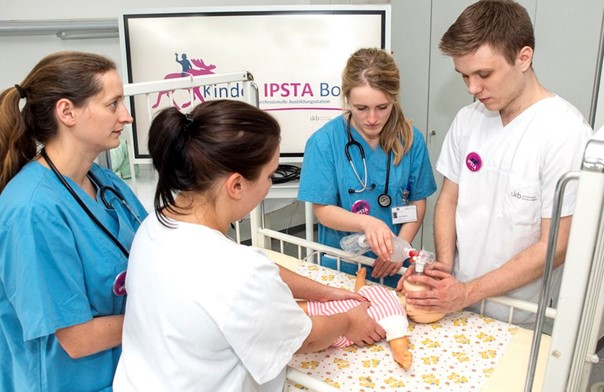Newsletter 2023
Newsletter September 2023: Enhancing Patient Safety through medical education - A crucial imperative
Authors:
Maria Wittmann, Gregor Massoth
Patient safety is a paramount concern within healthcare systems, and its significance has to extend heavily into medical education. It is essential that patients could be protected from harm during their treatment and receive safe and high-quality care. The quality of healthcare delivery relies heavily on the competence, knowledge, and attitudes developed by medical students and professionals during their lifelong education. As medical errors continue to pose a significant threat to patient’s well-being and increase healthcare costs, it is imperative that medical education institutions prioritise the integration of patient safety principles as early as possible into their curricula in various ways. The first component is creating awareness of the importance of patient safety among students, and then patient safety has to be implemented into medical education. Finally, research about improving patient safety created by those measures has to be done.
Understanding the importance of patient safety in medical education:
Preventing medical errors:
Medical errors can have severe consequences for patients, leading to morbidity, mortality, and increased healthcare costs. Medical education is pivotal in equipping future healthcare professionals with the knowledge, skills and attitudes necessary to minimise errors and promote patient safety. Competent healthcare professionals are less likely to create medical errors.
Shaping professional behaviour:
Patient safety education fosters a culture of accountability and responsibility, emphasising ethical conduct, effective communication, and teamwork. Such skills are vital for medical professionals to provide safe and high-quality care. Creating a shared mental model respectively mindset is important for this.
Addressing system-level issues:
Medical education should encompass an understanding of healthcare systems, including their complexities, challenges, potential areas for improvement, and their available resources and strong points. By teaching students the importance of incident reporting and the use of available resources (e.g., morbidity and mortality conferences), medical schools can contribute to a broader culture of continuous quality improvement, which is necessary and paramount in this ever-evolving field of knowledge.
Strategies to enhance patient safety in medical education:
Integration into curricula:
Patient safety education should be incorporated into the medical curricula across all stages of medical education, from preclinical to clinical training. Courses on error prevention, effective communication (as promoted by crisis resource management), teamwork, and patient-centred care can help cultivate a safety-conscious mindset early on and develop a high level of self-efficacy among future healthcare providers. This can be achieved by integrating interdisciplinary courses such as the ArHyPaRe at the University Hospital of Bonn (Germany). Inviting students to participate in ESAIC patient safety master classes might be another powerful tool by which these goals can be achieved.
Simulation-based training:
Immersive simulations allow students to practice critical decision-making and clinical skills in a controlled environment. These exercises can create realistic scenarios highlighting patient safety’s importance, helping learners develop appropriate responses and strategies without endangering real patients. Providing a well-structured debriefing facilitates highly valued learning moments concerning patient safety issues.
Interprofessional education:
Collaboration among healthcare professionals is essential for safe and effective patient care since the patients’ safety cannot be guaranteed by any health profession alone. This is why the World Health Organisation has emphasised the importance of interprofessional teaching as early as 2010. Incorporating interprofessional education into medical curricula enables students to understand the roles, responsibilities, and perspectives of different healthcare team members and vice versa, promoting effective teamwork and communication. Interprofessional seminars and simulations-enhanced training as well as interprofessional training wards such as the HIPSTA at the university hospital Heidelberg (Germany) are course formats by which this can be achieved.
Just culture and reporting systems:
Medical schools should promote a culture that encourages reporting errors, near misses, and adverse events influencing current and future healthcare staff. Advocating flat hierarchies might be pivotal, too. Implementing non-punitive reporting systems (e.g. the critical incident reporting system) and ensuring confidentiality can help identify system-level weaknesses and improve patient safety. It is essential to teach students at an early stage in their studies – for instance, in seminars – about these systems and how to use them.
Continual assessment and improvement:
Regular evaluation and feedback on patient safety competencies enable students to identify areas for improvement. This can be achieved by implementing mandatory objective structured clinical evaluations using both simulation-patients as well as mannequins in scenarios focussing on patient safety issues. Encouraging self-reflection and promoting a commitment to lifelong learning within patient safety cultivates a culture of excellence and adaptability. Engaging students with patient safety networks both on a local and international level (e.g. the ESAIC) might perpetuate their commitment to enhancing patient safety in their daily lives and future careers.
Research on the effects of patient safety education
The impact of the patient safety education program on organisational outcomes and goals should be assessed in a standardised way. This could involve examining key performance indicators related to patent protection, risk mitigation, or compliance with patent laws and regulations. Patient-reported outcomes on their own treatment should be included. Additionally, the medical students should be interviewed on how implementing patient safety into their curriculum has changed their attitudes and behaviour. Furthermore, both formative and summative assessments should be carried out.
Conclusion:
Implementing and enhancing patient safety in medical education is critical for healthcare systems worldwide. By emphasising the importance of patient safety throughout the curriculum with various means, medical education institutions can train competent and compassionate healthcare professionals who prioritise safe, high-quality care focusing on the patient and his well-being. Integrating patient safety principles, simulation-based training, interprofessional education, reporting systems, and continuous assessment will help nurture a culture of patient safety and ultimately contribute to improved patient outcomes – now and in the long run. These effects and outcomes need to be assessed in a standardised manner. As we strive for excellence in healthcare, investing in robust patient safety education will undoubtedly play a crucial role in shaping the future of medical practice.













